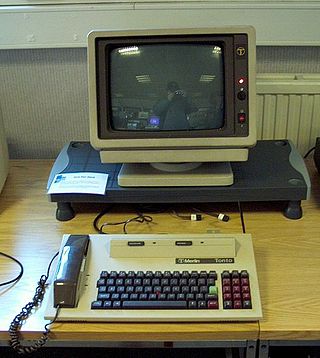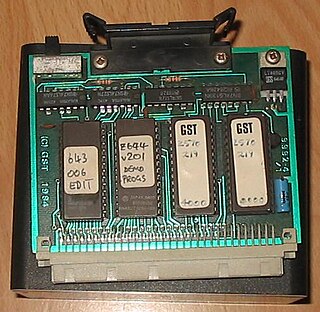
The Atari ST is a line of personal computers from Atari Corporation and the successor to the Atari 8-bit family. The initial model, the Atari 520ST, had limited release in April–June 1985 and was widely available in July. It was the first personal computer with a bitmapped color GUI, using a version of Digital Research's GEM from February 1985. The Atari 1040ST, released in 1986 with 1 MB of RAM, was the first home computer with a cost-per-kilobyte of less than US$1.
The Sinclair QL is a personal computer launched by Sinclair Research in 1984, as an upper-end counterpart to the ZX Spectrum.
MetaComCo (MCC) was a computer systems software company started in 1981 and based in Bristol, England by Peter Mackeonis and Derek Budge. A division of Tenchstar, Ltd.
Loki was the code name for a cancelled home computer developed at Sinclair Research during the mid-1980s. The name came from the Norse god Loki, god of mischief and thieves. Loki was based on the ZX Spectrum, but intended to rival the Amiga for video games.
QDOS is the multitasking operating system found on the Sinclair QL personal computer and its clones. It was designed by Tony Tebby whilst working at Sinclair Research, as an in-house alternative to 68K/OS, which was later cancelled by Sinclair, but released by original authors GST Computer Systems. Its name is not regarded as an acronym and sometimes written as Qdos in official literature.
SMSQ/E is a computer operating system originally developed in France by Tony Tebby, the designer of the original QDOS operating system for the Sinclair QL personal computer. It began life as SMSQ, a QDOS-compatible version of SMS2 intended for the Miracle Systems QXL emulator card for PCs. This was later developed into an extended version, SMSQ/E, for the Atari ST. It consists of a QDOS compatible SMS kernel, a rewritten SuperBASIC interpreter called SBasic, a complete set of SuperBASIC procedures and functions and a set of extended device drivers originally written for the QL emulator for the Atari ST.
SuperBASIC is an advanced variant of the BASIC programming language with many structured programming additions. It was developed at Sinclair Research by Jan Jones during the early 1980s.
Sinclair Research Ltd is a former British consumer electronics company founded by Clive Sinclair in Cambridge. It was originally incorporated in 1973 as Westminster Mail Order Ltd, renamed Sinclair Instrument Ltd, then Science of Cambridge Ltd, then Sinclair Computers Ltd, and finally Sinclair Research Ltd. It remained dormant until 1976, when it was activated with the intention of continuing Sinclair's commercial work from his earlier company Sinclair Radionics, and adopted the name Sinclair Research in 1981.
Minerva is a reimplementation of Sinclair QDOS, the built-in operating system of the Sinclair QL line of personal computers. Written by Laurence Reeves in England, Minerva incorporates many bug fixes and enhancements to both QDOS and the SuperBASIC programming language. Later versions also provide the ability to multi-task several instances of the SuperBASIC interpreter, something not supported by QDOS.

Miracle Systems Ltd. were a manufacturer of personal computer peripherals and upgrades, specializing in the Sinclair QL, in the 1980s and early 1990s.

The One Per Desk, or OPD, was an innovative hybrid personal computer/telecommunications terminal based on the hardware of the Sinclair QL. The One Per Desk was built by International Computers Limited (ICL) and launched in the UK in 1984. It was the result of a collaborative project between ICL, Sinclair Research and British Telecom begun in 1983, originally intended to incorporate Sinclair's flat-screen CRT technology.
The CST Thor series of personal computers are Sinclair QL-compatible systems designed and produced by Cambridge Systems Technology during the late 1980s.
GST was a group of computer companies based in Cambridge, England, founded by Jeff Fenton in June 1979. The company worked with Atari, Sinclair Research, Torch Computers, Acorn Computers, Monotype Corporation and Kwik-Fit, amongst others.
The Q40 and Q60 are computer motherboards designed in the late 1990s, based on the Motorola 68040 and 68060 microprocessors respectively and intended to be partially compatible with the Sinclair QL microcomputer. Later these were sold as a fully assembled computer in an AT desktop case.

The history of the personal computer as a mass-market consumer electronic device began with the microcomputer revolution of the 1970s. A personal computer is one intended for interactive individual use, as opposed to a mainframe computer where the end user's requests are filtered through operating staff, or a time-sharing system in which one large processor is shared by many individuals. After the development of the microprocessor, individual personal computers were low enough in cost that they eventually became affordable consumer goods. Early personal computers – generally called microcomputers – were sold often in electronic kit form and in limited numbers, and were of interest mostly to hobbyists and technicians.

68K/OS was a computer operating system developed by GST Computer Systems for the Sinclair QL microcomputer.

Home computers were a class of microcomputers that entered the market in 1977 and became common during the 1980s. They were marketed to consumers as affordable and accessible computers that, for the first time, were intended for the use of a single, non-technical user. These computers were a distinct market segment that typically cost much less than business, scientific, or engineering-oriented computers of the time, such as those running CP/M or the IBM PC, and were generally less powerful in terms of memory and expandability. However, a home computer often had better graphics and sound than contemporary business computers. Their most common uses were word processing, playing video games, and programming.





